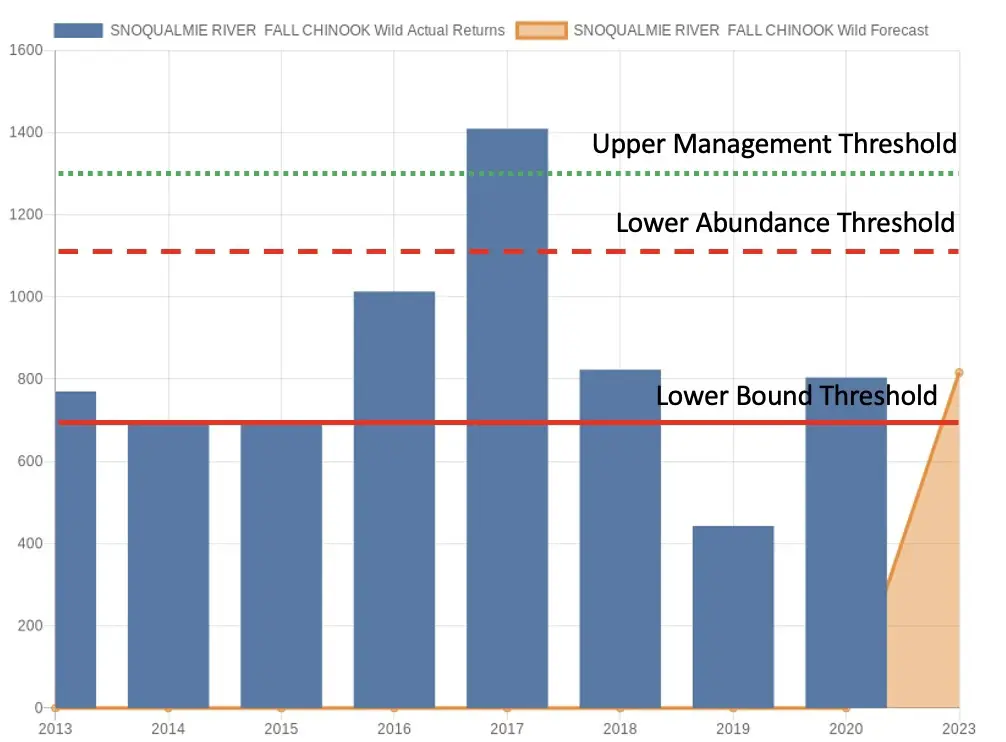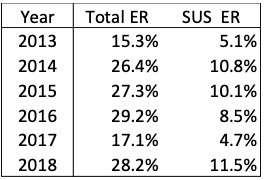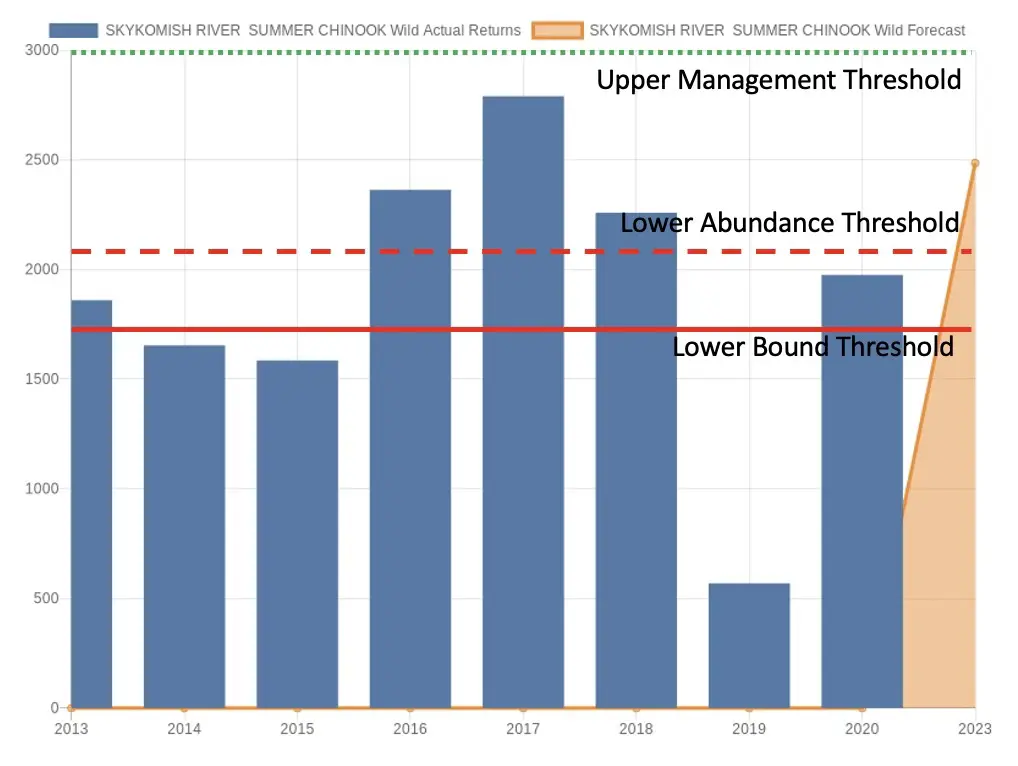
As many of you are now aware, we’ve lost most of the fishing opportunities in 2023 to pursue Skykomish summer chinook and summer steelhead returning in the same timeframe.
The Skykomish summer chinook fishery is an incredible opportunity close to home for many folks in the north Puget Sound region represents a massive amount of business for local guides and the surrounding businesses and fills a hole in the fishing calendar.
How did this happen? And what does it mean for the future of this fishery? Let’s explore together using the data available from the North of Falcon Process and the Management Plan for Puget Sound Chinook agreed upon between the Tribes and WDFW.
There are a few really important dynamics to understand about how these fisheries are managed, how that management has been adjusted over the past decade, and the significance of a few events from 2019 until now.
Let’s break them down one by one to get an accurate picture of what happened in 2023 and what to expect going forward:
Northern Fisheries take a massive amount of Snohomish Basin Chinook
A great reference to gain more background on the history of how these fisheries have been managed in the past is Frank Haw’s book “Washington Sport of Kings”. But, a quick and easy way to understand it is that Alaska takes Canada’s fish and Canada takes our fish as most salmon migrate north.
The greatest amount of Snohomish Basin chinook salmon are taken off of the West Coast of Vancouver Island both commercially and recreationally and it’s not even close.
Combine that fact with the reality that we have very little control or influence on curtailing the exploitation rate (% of a particular fish stock harvested) of these northern fisheries.
Additionally, Canada doesn’t fin clip the majority of their hatchery fish and does not manage “mark selective” fisheries (only harvesting fin-clipped salmon).
The way the process of taking input from northern fisheries works in our North of Falcon season-setting process is they give us a number and we put that number in our models. No negotiations, no ability to push back.
When do we get to negotiate the Pacific Salmon Treaty again? 2028…

Take a look at the above table examining some historical Total ER (Total Exploitation rates: Northern + Southern) compared to SUS ER (Just Southern US exploitation rate, which is our fisheries).
In those 6 years, the Total ER exceeded 20% 4 times and the Northern part of the Total ER ranged from 10% to almost 20% throughout this period…
Keep that 20% figure in your head as it’s important.
Remember, this is just one piece of the puzzle, keep reading for the rest.
2019 was a really challenging year for Snohomish Basin Natural Origin Chinook

Let’s start with looking at Skykomish summer chinook. These various thresholds determine what the Southern US (SUS) Exploitation Rate (ER) is set to.
The simple way to understand it is if more natural (wild) origin chinook return, the ER gets set to a higher number, meaning our seasons are set to allow for more take and more encounters with unclipped fish.
If fewer of these wild stocks return, we get a lower number. If you look at the above graph, you can see that 2019 was a really challenging year, but that only 3 of the past 10 years have been below the LBT (Lower Bound Threshold), and 4 of the past 10 years have been below the LAT (Lower Abundance Threshold).
While not great, the situation doesn’t appear dire with regards to having a fishery most years.
For most of these years, an ER ceiling of 23% was used vs the 20% we now have in the agreed-upon Management plan set in place in 2022. This is why that 20% number is really important to keep thinking about as you walk through this.

Now take a look at the Snoqualmie River fall chinook situation…
Only 6 of the past 10 years were above the LBT and only 1 of the past 10 years were above the LAT…This is a significant challenge going forward for a few reasons:
First, you may be wondering what the Snoqualmie River run of wild chinook has to do with the Skykomish when the fishery is only allowed on the Skykomish.
The reality is we don’t know…and when the scientists from WDFW and the Tribes don’t have data proving the opposite, there’s an assumed relationship such that IF the Snoqualmie has an issue, the entire Snohomish Basin is managed at the lower ER %.
This is inline with a conservation-first management principle that’s hard to find fault with.
2019 was a difficult year for the Snohomish Basin, and it may take several more years to get back above the LAT threshold which would lift the ER Ceiling slightly…
But why did we always have a fishery in the past?
This was my #1 question last week as this issue came into focus. Because it doesn’t seem like much has changed and even in 2019 there was a fishery, so what gives?
If you’ve been paying attention to what’s happened with the Canada chinook salmon fisheries, you remember that there was a massive shutdown of fishing that took place in several of the past few years. 2020-2022 all had reduced fishing and if I remember correctly one (or was it two?) of those years had a total shutdown of the West Coast Vancouver Island chinook fishery.
That translated to more opportunity for Southern US fisheries i.e. Puget Sound and in-river fisheries like the Skykomish Summer Chinook fishery.
In fact, there hasn’t been a single year like 2023 where all these factors have come together:
- A normal ER% from Canada, which depending on the year could take ALL the exploitation rate available.
- The new Management Plan between Tribes and WDFW set the ER’s to slightly lower ceilings for a Total ER of 20% and Southern US fisheries of 8.3% given the current abundance thresholds
- The abundance of natural origin Snoqualmie chinook is lower as a result of the disastrous 2019 return year.
Those three factors taken together translate to almost zero quota of wild chinook encounters left for the in-river fishery.
So where did our 8.3% go if not for the in-river fishery?
Some went to our ocean waters tribal and non-tribal troll (commercial). A little bit went to the Area 7 sport season, a little bit went to Area 9 sport. Some more went to Area 5 sport. Another little bit went to Area 10 sport…A little bit went to Tribal Tulalip Bay nets…
Most of the impact is actually sport / recreational fishing in the marine areas.
Do you get the idea? Death by many tiny cuts from the marine fisheries. One of the major changes to the saltwater season setting late in the game was reducing thousands of fish from the area-specific quotas just to save a few wild Snoqualmie fall chinook (and Stillaguamish chinook, and Nooksack springs and …)
We would have to shut down entire areas which would remove significant opportunities to harvest hatchery chinook throughout the ocean and Puget Sound, just to enable a fishery on the Skykomish, which is probably not the right thing to do.
The reality is that 8.3% doesn’t go very far for Southern US fisheries, and despite what some people think, the tribe and the nets are not to blame here. They are taking a very small number of these fish compared to the total harvested outside of tribal fisheries.
Okay, so 2023 will suck, but what about 2024 and beyond?
I wish I could paint a positive picture here, but even if we make significant progress back from 2019 in terms of the abundance of these stocks, the Management Plan thresholds combined with a full Canadian fishery translates to an increased likelihood of a very limited season on the Skykomish River summer chinook in the future.

Remember that table? Most of the Total ER is not something we control. This means Canada can hand us a number and that number can instantly translate to limited or no fishing on these stocks.
And the number they hand us is extremely likely to be problematic given we have a total ER of 20%…unless we have a banner return year of natural origin Chinook…
What’s the solution? How do we get this opportunity back?
There are a few potential solutions here, each with their challenges:
- Ideally, we can fish on mark-selective summer chinook on the Skykomish between Sultan and the Wallace flats. But, we need data that proves there would be no impact on Snoqualmie Fall Chinook. How do we get that data?
Also, the Management Plan would have to be amended to make these thresholds independent vs right now, an issue in one river can trigger a complete closure of the Snohomish Basin.
2. I don’t know how hard this is, but the Pacific Salmon Treaty needs to be re-negotiated in 2028 to deal with many issues that make Southern US Fisheries unnecessarily challenging.
Can Canada really afford to continue unmarked fishery prosecution given the downward nose dive wild chinook stocks are taking coast-wide? Can we (Alaska, Washington, Oregon) afford to let them continue?
This probably requires Alaska to make adjustments as well, a tall order when our bargaining position is probably not the greatest. I don’t know enough about all of this, but I do know there are several outcomes that could help us significantly here.
3. Predation. Remember that NOAA study that showed marine mammals take 7x more salmon than all commercial and recreational fisheries combined?
Also, WDFW had a study done to look at the impact of sea lions and harbor seals and shared the results with us as part of the North of Falcon process in 2023. There’s no longer a significant debate about this topic even if it seemed like a settled matter, this development is very positive.
However, the Marine Mammal Predation Act is a significant barrier to any kind of lethal removal of these critters. Options are being pursued but it may take years to bear fruit.
What about birds though? Can we encourage a greater take on the salmon-eating avian predators? Isn’t that something WDFW could do right now?
Wrapping up
I hope this helped us all better understand the situation we are faced with. The most important takeaway I want to leave you with is:
Don’t think that 2023 is a one-off and we are just going to get everything back to what it used to be after this year. 2023 only is the beginning of the challenge with this fishery and our ability to get the opportunity back in the future requires continued activism, effort, and focus on our part to see it happen.
None of the above-mentioned solutions are easy or even likely without significant public pressure on the parties involved.
Also, one last thing: The numbers are not just models and crap people make up managing spreadsheets, they come from boots-on-the-ground, counting redds in these rivers.
We all probably know that fishing buddy who likes to say stuff like “There’s no more wild fish” and will happily drag an unclipped fish aboard his boat because he thinks he’s screwing the “bureaucrats”…No, he’s screwing you and me.
Let’s continue to educate our fellow anglers and call out these people’s ignorance. I don’t believe this contributes much to the decline of wild salmon back on the spawning ground, because these types of anglers are the exception, not the norm. But every little bit helps.
Also, for the saltwater fisherman….buy a knotless net and handle unclipped fish the best possible way, we need these fish counted on the redds not bleeding out on your boat.
Every little bit helps.
Draggers are destroying kings.
They look at bycatch adult salmon.
What about juvenile fish being crushed never accounted for the future of our runs.
If draggers won’t be stopped there will be no more fish in Alaska
As a Canadian two corrections. Canada does manage some fisheries with a mark selective process but not enough. The West Coast of Vancouver Island has been closed in spring and summer from 2019 through 2023 except for tiny areas near rivers that should have mostly local fish. Some large areas were even completely closed al ALL fishing. The public fishery anglers are fighting as hard as we can to get to mass marking and mark selective fisheries but other more politically popular groups are fighting back even harder. Science does not matter much to Canada’s government. Finally I hate that anybody’s ocean fishery could prevent someone else’s river fishery. We need to share the fish and the habitat (get rid of AK ocean ranched pinks) fairly.
Thanks for commenting here and adding another perspective!
If you don’t think these fish swim in the gulf of Alaska you have no knowledge of salmon. The trawl fleet in the gulf of Alaska has very limited observer rates and self report their bycatch with pretty much no limit. That is where most all chinook are disappearing. Not in sealion gullets, not in gillnets, not in warm waters of climate change..but tossed over board as three companies make as much bleached fake crab and fish sticks as possible. They even sell you the idea as sustainable on your new hockey team in Seattle.
Interesting! Tell me more. Which 3 companies? And, it does make sense if observability is low that we wouldn’t have models around fish being lost op there